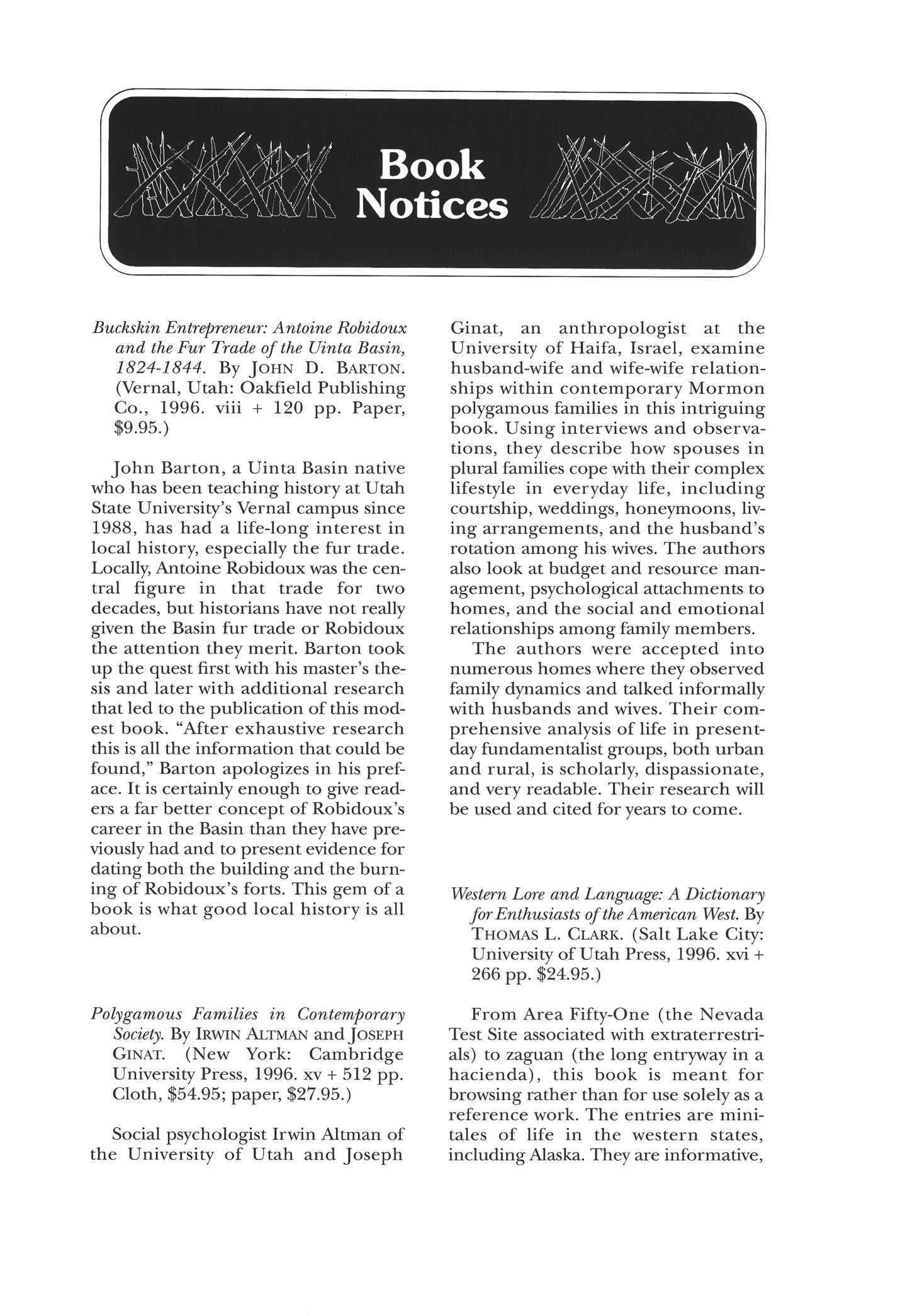
5 minute read
Book Notices
Buckskin Entrepreneur: Antoine Robidoux and the Fur Trade of the Uinta Basin, 1824-1844.
By JOHN D. BARTON. (Vernal, Utah: Oakfield Publishing Co., 1996. viii + 120 pp. Paper, $9.95.)
John Barton, a Uinta Basin native who has been teaching history at Utah State University's Vernal campus since 1988, has had a life-long interest in local history, especially the fur trade Locally, Antoine Robidoux was the central figure in that trade for two decades, but historians have not really given the Basin fur trade or Robidoux the attention they merit. Barton took up the quest first with his master's thesis and later with additional research that led to the publication of this modest book. "After exhaustive research this is all the information that could be found," Barton apologizes in his preface It is certainly enough to give readers a far better concept of Robidoux's career in the Basin than they have previously had and to present evidence for dating both the building and the burning of Robidoux's forts This gem of a book is what good local history is all about.
Polygamous Families in Contemporary Society.
By IRWIN ALTMAN and JOSEPH GINAT (New York: Cambridge University Press, 1996. xv + 512 pp. Cloth, $54.95; paper, $27.95.)
Social psychologist Irwin Altman of the University of Utah and Joseph Ginat, an anthropologist at the University of Haifa, Israel, examine husband-wife and wife-wife relationships within contemporary Mormon polygamous families in this intriguing book Using interviews and observations, they describe how spouses in plural families cope with their complex lifestyle in everyday life, including courtship, weddings, honeymoons, living arrangements, and the husband's rotation among his wives The authors also look at budget and resource management, psychological attachments to homes, and the social and emotional relationships among family members. The authors were accepted into numerous homes where they observed family dynamics and talked informally with husbands and wives Their comprehensive analysis of life in present day fundamentalist groups, both urban and rural, is scholarly, dispassionate, and very readable. Their research will be used and cited for years to come.
Western Lore and Language: A Dictionary for Enthusiasts of the American West.
By THOMAS L CLARK (Salt Lake City: University of Utah Press, 1996 xvi + 266 pp $24.95.)
From Area Fifty-One (the Nevada Test Site associated with extraterrestrials) to zaguan (the long entryway in a hacienda), this book is meant for browsing rather than for use solely as a reference work. The entries are minitales of life in the western states, including Alaska. They are informative, amusing, and thought provoking in turn Clark tells us, for example that carrot eater/carrot snapper and cricket stomper are derogatory terms Idahoans use for a Utahn, particularly a Mormon—sometimes in response to being called spud head or spud eater by a Utahn or a Mormon The author is sure to get many suggestions for inclusion in a future revised edition.
The Saloon on the Rocky Mountain Mining Frontier.
By ELLIOTT WEST. (Lincoln: University of Nebraska Press, 1996. xvii + 197pp.Paper, $12.00.)
Originally issued in 1979, Elliott West's look at the role of the saloon in mining towns provides insights into both economic and social history Park City saloonkeeper Jack Pape, for example, is cited as an example of the barkeeper with a conscience. He sponsored benefits to raise money for a firehouse, cemetery improvements, aid to orphans, etc West traces the evolution of saloons from tents and shanties to elaborate establishments that offered gambling and other forms of entertainment, not to mention vice
Ernest Haycock.
By STEPHEN L TANNER Twayne's United States Authors Series. (New York: Twayne Publishers, 1996. xii + 150 pp. $26.95.)
Ernest Haycock was a highly successful writer of westerns In moving from pulp magazines, to slicks like Collier's, to books selected by literary clubs, Haycock broke away from stereotypes of the genre and explored the darker side of the psyche Hisheroes are complex figures with both strengths and weaknesses and conflicting moral codes. Bugles in the Afternoon (1944), one of Haycock's best-known novels, even won grudging admiration from Bernard DeVoto, who thought itwas historically sound and "almost a good novel."
Stephen Tanner, a professor of English at Brigham Young University, examines Haycock's life and development asa writer and brings a fresh, critical perspective to a genre that is often dismissed as second-rate.
White Man's Wicked Water: The Alcohol Trade and Prohibition in Indian Country, 1802-1892.
By WILLIAM E UNRAU (Lawrence: University Press of Kansas, 1996. xi + 180 pp. $25.00.)
This book is not for the fainthearted In his epilogue, William Unrau, a distinguished research professor at Wichita State University, horrifies us with late twentieth-century statistics on alcohol and American Indians: Alcohol-related deaths are three to four times higher for Indians than the rest of the population; alcohol is a significant factor in high rates of homicide, suicide, car accidents, and family abuse; and chronic alcohol consumption bypregnant Indian women is having a devastating effect on their unborn children White Man's Wicked Water is not about this appalling situation, however, but about howand why an alcohol-sodden white society introduced drink to Native Americans in the nineteenth century and subsequently tried, with little success, to prohibit the sale of alcohol to Indians







